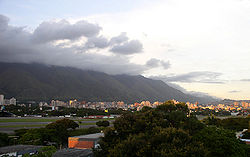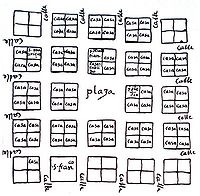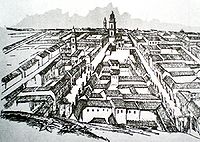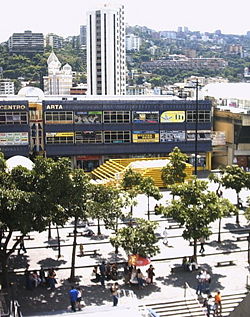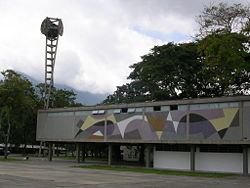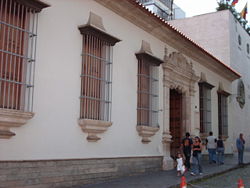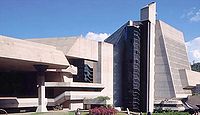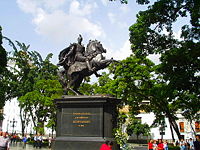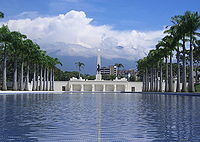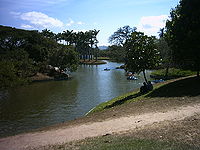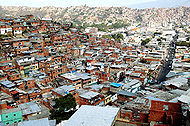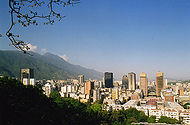Caracas
| Santiago de León de Caracas | |||
|
|||
| Nickname: La Sultana del Avila (English:The Avilas' Sultan) La Sucursal del Cielo English: Heaven's branch (on earth) | |||
| Motto: Ave María Santísima, sin pecado concebida, en el primer instante de su ser natural. (English: Hail Holiest Mary, conceived without sin, in the first instant of Your Natural Being) | |||
| Coordinates: 10°30′N 66°55′W | |||
|---|---|---|---|
| Country | Venezuela | ||
| States | Capital District, Miranda | ||
| Municipalities | Libertador, Chacao, Baruta, Sucre, El Hatillo | ||
| Founded | July 25, 1567 | ||
| Government | |||
| - Mayor | Juan Barreto (MVR) | ||
| Area | |||
| - Total | 1,930 km² (745.2 sq mi) | ||
| Elevation | 900 m (2,953 ft) | ||
| Population (2005) | |||
| - Total | 3,140,076 | ||
| - Density | 1,431.5/km² (3,707.6/sq mi) | ||
| - Demonym | caraqueño(a) | ||
| Time zone | VST (UTC-4:30) | ||
| - Summer (DST) | not observed (UTC-4:30) | ||
| Postal code | 1010-A | ||
| Area code(s) | 0212 | ||
| The area and population figures are the sum of the figures of the five municipalities (listed above) that make up the city of Caracas | |||
| Website: alcaldiamayor.gob.ve (Spanish) | |||
Caracas (pronounced [kaˈɾakas]) is the capital and largest city of Venezuela. It is located in the north of the country, following the contours of a narrow mountain valley located on the Venezuelan coastal range (Cordillera de la Costa). The valley's temperatures are springlike, and the urbanized terrain of the Caracas Valley lies between 2,500 and 3,000 ft (760 and 910 m) above sea level. The valley is close to the Caribbean Sea, separated from the coast by a steep mountain range (Cerro Ávila) that rises above 7400 ft (2200 m); to the south lies further hills and mountains.
Geography
Etymology of name – if available. Caracas is contained entirely within a valley of the Venezuelan central range, and separated from the Caribbean coast by a roughly 15km expanse of El Ávila National Park. The valley is relatively small and quite irregular.
The elevation from sea level varies from between 2854 to 3422 feet (870 and 1043 meters), with 2953 feet (900 meters) in the historic zone. This, along with the rapid population growth, has profoundly influenced the urban development of the city. The most elevated point of the Capital District, wherein the city is located, is the Pico El Ávila, which rises to 7083 feet (2159 meters).
The city enjoys an intertropical climate. The average maximum daytime temperature of the coldest month, January, is 72°F (22°C), and the average of the warmest month, May, 75°F (24°C). Abundant fog may appear in December and January, with a sudden nightly drop in temperature to 55°F (13°C). Caracas natives call this weather the Pacheco. Precipitation varies between 35 and 51 inches (900 and 1300mm) annually, in the city proper, and up to 79 inches (2000mm) in some parts of the mountain range. Hail storms occur rarely, while electrical storms are more frequent.
The Guaire river flows across the city and empties into the Tuy river, which is also fed by the El Valle and San Pedro rivers, in addition to numerous streams which descend from El Ávila. The La Mariposa and Camatagua reservoirs provide water to the city.
Size – land area, size comparison Environmental issues Districts
History
More than five hundred years ago, the area was populated by indigenous peoples and Caracas did not exist. Francisco Fajardo, a Spanish colonial, attempted to establish a plantation there in the year of 1562. Fajardo's stay in the valley did not last long, and he was expelled by the locals. This was the last rebellion on the part of the aborigines, for on July 25, 1567, the Spanish captain Diego de Losada laid the foundations of the city of Santiago de León de Caracas. The cultivation of cocoa stimulated the development of the city which became the capital of the province of Venezuela.
An attempt at revolution to gain independence organized by José María España and Manuel Gual was put down on July 13, 1797. But the ideas of the French Revolution and the American Revolutionary War inspired the people, and on July 5, 1811 a Declaration of Independence was signed in Caracas.
This city was the birthplace of two of Latin America's most important figures: Francisco de Miranda and "El Libertador" Simón Bolívar. An earthquake destroyed Caracas on March 26, 1812 and was portrayed by authorities as a divine punishment for rebelling against the Spanish Crown, during the Venezuelan War of Independence. The valley became a cemetery, and the war continued until June 24, 1821, when Bolívar gained a decisive victory over the Royalists at Carabobo.
As the economy of oil-rich Venezuela grew steadily (during the first part of the 20th Century), Caracas became one of Latin America's economic centers, and was also known as the preferred hub between Europe and South America. During the 1950s, Caracas began an intensive modernization program which continued throughout the 1960s and early 1970s. The Universidad Central de Venezuela, designed by modernist architect Carlos Raúl Villanueva and now a UNESCO monument, was built. Joining El Silencio, also by Villanueva, several workers' (23 de Enero, Simon Rodriguez) and new middle class residential districts (Bello Monte, Los Palos Grandes, Chuao, Cafetal, etc.) sprouted in the valley, extending its limits towards the East and South East. On October 17 2004, one of the Parque Central towers caught fire. The change in the economic structure of the country, now oil dependent, and the fast development of Caracas made it a magnet for the rural communities who migrated to the capital city in an unplanned fashion, creating the ranchos (slum) belt in the valley of Caracas.
Reference: The history and geography of a valley, by Maurice Wiesenthal, article appeared in the book Caracas, published in 1981.
Government
Venezuela is a federal republic. The president is both the chief of state and head of government, and is elected by popular vote for a six-year term. The Council of Ministers is appointed by the president. The unicameral National Assembly has 167 members elected by popular vote to serve five-year terms. Three seats are reserved for the indigenous peoples of Venezuela.
The Metropolitan District of Caracas is the official name of the district governed as Caracas. Caracas has five municipalities: Baruta, El Hatillo, Chacao, Libertador and Sucre.
The constitution of Venezuela specifies that municipal governments be divided into executive and legislative branches. The mayor manages executive government, while the municipal council manages legislative government. In March 8, 2000, the year after a new constitution was introduced in Venezuela, it was decreed that some of the powers of these municipalities would be delegated to the Alcaldía Mayor, physically located in Libertador municipality.
Economy
Venezuela remains highly dependent on oil revenues, which account for roughly 90 percent of export earnings, more than 50 percent of the federal budget revenues, and around 30 percent of GDP.
As the national capital, and as host to embassies of all countries of the world, government services are especially important in the Caracas economy, as is the entire service sector, that includes wholesale and retail trade, transportation and public utilities, education and health care. The city is the location for the head offices for Venezuela’s rporations, banks, and insurance companies, as well as the Caracas Stock Exchange.
Caracas also hosts Petróleos de Venezuela (PDVSA) which is the main company of the country, that negotiates all the international agreements for the distribution and export of petroleum.
Caracas is Venezuela's leading manufacturing centre, producing chemicals, textiles, leather, food and beverages, iron and wood, paper, and printing products, chemicals, and pharmaceuticals, as well as metalware and plastics. There are also important rubber and cement factories.
Per capita GDP, rank
Tourism
Transport: Road, rail, air, sea
Transportation
xxxx Caracas is linked directly with other major urban centres of the world by air and ocean transport. Maiquetía Airport, located 10 miles (16 km) by road from Caracas on the coast, provides international connections as well as domestic flights to all parts of the republic. Two smaller airports, La Carlota and Francisco de Miranda, also serve the city. La Guaira and, to a lesser extent, Puerto Cabello are the natural seaports for Caracas and handle most of its import and export trade. A modern superhighway, including two long tunnels through the mountains, leads from Caracas to Maiquetía, La Guaira, and various beaches and resort areas along the coast. It was opened in 1953 to replace a tortuous 21-mile (34-km) zigzag route.
Within the city large numbers of buses, private automobiles, and taxis provide transportation, but during rush hours they clog the streets in what has become an increasing problem of traffic congestion. The public transportation system, although deficient, improved greatly with the inauguration, in 1983, of a modern subway system. Traffic is also facilitated by a system of autopistas, multilane divided highways extending east–west through the valley and connecting the city with interior locations. Railroads, which once provided Caracas with vital links to the sea and to interior valleys, have been abandoned in favour of highway transportation.
xxxx
- The Caracas Metro has been in operation since 1981. With 04 lines and more than 50 stations, it covers a great part of the city, it also has an integrated ticket system, that combines the route of the Metro with those offered by the Metrobús, a bus service of the Caracas Metro. The Metro system works from 5:30 a.m. to 11:00 p.m.
- Buses are the main means of mass transportation. There are two bus systems: the traditional system and the Metrobús. The traditional system runs a variety of bus types, operated by several companies on normal streets and avenues:
- Autobus; large buses.
- Camioneta; medium size buses.
- microbus or camionetica; vans or minivans.
- IAFE; train services to and from Tuy Valley cities of Charallave and Cúa.
- The Simón Bolívar International Airport, the biggest and most important in the country is located outside the city, roughly 20 miles from the downtown area. Taxis and Buses are available at the airport to provide transportation to the city.
Demographics
The city of Caracas had an estimated population of 3,140,076 in 2005. The population of Greater Caracas' urban agglomeration (including neighboring cities out of the Capital District) is approximately 4.7 million people.[1] Caracas was ranked as the world's 119th largest urban area.
The mixture of races and cultures has been an accepted part of life in Caracas. During colonial times, Spaniards mixed with local native Indians and again with African slaves brought to work on the cocoa and coffee fields. Independence and the discovery of petroleum brought European immigrants. The 1980s and 1990s saw growing numbers of immigrants hailing from neighboring countries such as Colombia, Ecuador, Peru, Bolivia, Trinidad and Tobago, and Haiti.
Therefore, it is not difficult to find blond people with dark eyes, as well as very dark people with blondish hair and blue eyes. Nevertheless, the common demography would be "mulatos" (people of mixed black and white ancestry), "mestizos" (mixed white and native Indian), and "criollos" (an amalgamation of three races).
The city has grown haphazardly. No demographic planning has ever been carried out, thus there are entire districts and neighborhoods of Caracas lacking water and electrical systems, not to mention other services like schools, hospitals, police, fire departments. Therefore, some suburbs and districts are lawless.
The most widely-spoken and official language is Spanish, although English is used in tourist facilities. About 31 indigenous languages are spoken. European immigrant communities and their descendants commonly use their own native languages.
Nominally 96 percent of the population is Roman Catholic, two percent are Protestant, and the remainder follow other religions.
The Central University of Venezuela is a premier public University, one of 13 universities located in Caracas. Founded in 1721, it is the oldest university in Venezuela and one of the first in Latin America. Universidad Simón Bolívar is a public institution located in Caracas, Venezuela with a scientific and technological orientation.
Of interest
Ciudad Universitaria
The main campus of the Central University of Venezuela, designed by the renowned architect Carlos Raúl Villanueva and declared World Heritage by UNESCO in 2000, is considered to be a masterwork of Modern Architecture and Art. Over 28 artists from the Modern Avant-garde participated in the project. Among them Hans Arp, Alexander Calder, Fernand Léger, Victor Vasarely with the Venezuelans Francisco Narváez, Alejandro Otero and Oswaldo Vigas.
Capitolio Federal
The Capitolio Federal occupies an entire city block, and, with its golden domes and neoclassical pediments, can seem even bigger. The building was commissioned by Antonio Guzmán Blanco in the 1870s, and is most famous for its Salón Elíptico, an oval hall with a mural-covered dome and walls lined with portraits of the country's great and good.
Visit on Independence Day and you'll catch a glimpse of the original Act of Independence of 1811, installed inside a pedestal topped by a bust of Bolívar and displayed only on this most auspicious of public days. The halls surrounding the salon are daubed with battle scenes commemorating Venezuela's fight for independence.
Parque del Este
Designed by Brazilian architect Roberto Burle Marx. A green paradise in the middle of the city, where diverse activities can be done. A park where typical animals can be seen in a little zoo. A replica of the ship led by Francisco de Miranda, the Leander, maybe will build in the southern part of the park. There was a replica of the Santa Maria ship, used by Christopher Colombus in his voyages to discover America. This replica was destroyed by the government of Hugo Chavez
Teresa Carreño Cultural Complex
The Teresa Carreño Cultural Complex (Complejo Cultural Teresa Carreño), or more commonly the Teresa Carreño Theater (Teatro Teresa Carreño), is one of the most important Theaters of Caracas and Venezuela, where symphonic and popular concerts imagine frequently, operas, ballet and theater. It is located near the Seat of the museums, the Caobos Park and the Athenian of Caracas, in the cultural zone of the city. It is divided in two rooms: Jose Felix Ribas and Ríos Reyna. It is constructed on a site of 22 thousand square meters. The theater was thus named in honor of the Venezuelan pianist Teresa Carreño. It is famous for displaying numerous permanent works of art, like hanging sculptural objects by the late Venezuelan artist Jesús Soto, and the artistic intervention and modification of one of the theater's great outside walls, by polish/Venezuelan artist Harry Abend.
Casa Natal de Bolívar
Skyscrapers may loom overhead, but there's more than a hint of original colonial flavor in this neatly proportioned reconstruction of the house where Simón Bolívar was born on July 24, 1783. The museum's exhibits include period weapons, banners and uniforms.
Much of the original colonial interior has been replaced by monumental paintings of battle scenes, but more personal relics can be seen in the nearby Museo Bolivariano. Pride of place goes to the coffin in which Bolívar's remains were brought from Colombia; his ashes now rest in the National Pantheon.
Bolívar's funeral was held 12 years after his death at the Iglesia de San Francisco, just a few blocks west, and it was also here that he was proclaimed 'El Libertador' in 1813. The church dazzles the eye with its richly gilded baroque altarpieces, and still retains much of its original colonial interior, despite being given a modernizing once-over by Guzmán Blanco.
Museo de Arte Colonial
The gardens that surround this museum are almost as enticing as its interior. The museum is housed in a gorgeous colonial country mansion known as Quinta Anauco, which is surrounded by beautiful greenery. Inside the house you'll find meticulously restored rooms, filled with carefully selected works of art, furniture and period household and many other historical artifacts.
The "Quinta" was well outside the historic town when it was built back in 1797, but today it's an oasis in the inner suburb of San Bernardino. Head there late on a Sunday morning and you might catch a chamber music concert in rooms which were once the house stables
Panteón Nacional
Venezuela's most venerated building is five blocks north of Plaza Bolívar, on the northern edge of the old town. Formerly a church, the building was given its new purpose as the final resting place for eminent Venezuelans by Antonio Guzmán Blanco in 1874. The entire central nave is dedicated to Bolívar, with the altar's place taken by the hero's bronze sarcophagus, while lesser luminaries are relegated to the aisles. The national pantheon's vault is covered with 1930s paintings depicting scenes from Bolívar's life, and the huge crystal chandelier glittering overhead was installed in 1883 on the centennial of his birth. It's worth hanging around to catch the ceremonial changing of the guard, held several times a day.
Parque Central
At a short saunter east of Plaza Bolívar is Parque Central, a concrete complex of five high-rise residential slabs of somewhat apocalyptic-appearing architecture, crowned by two 53-storey octagonal towers, one of them is under repair due to the fire which burned the building on October 17, 2004.
Parque Central is Caracas' art and culture hub, loaded with museums, cinemas, the Teresa Carreño Cultural Complex, and the Caracas Athenaeum, home to the esteemed Rajatabla theatre company. The Mirador de la Torre Oeste, on the 52nd floor, gives a 360° bird's-eye view of the city.
Plaza Bolívar
Leafy Plaza Bolívar is the focus of the old town with the inevitable monument to El Libertador, Simon Bolívar, at its heart. Modern high-rise buildings have overpowered much of the colonial flavor of Caracas' founding neighborhood. But the lively area still boasts some important sites.
The Museo Caracas on the ground floor highlights local history, and has some great models of the city as it appeared in the early 19th century and 1930s. To grasp just how much this city has grown, take a look at the map dating from 1578 in the building's central courtyard.
El Hatillo
El Hatillo is a colonial town located at the south-east suburbs of Caracas in the municipal area of the same name. This small town, which is one of Venezuela's few well-preserved typical colonial areas, gives an idea of what Caracas was like in centuries past. Just like every town in Venezuela, El Hatillo has its own Plaza Bolívar with El Libertador's statue in the middle. It also has a well preserved Roman Catholic Church, and many colonial houses. Even the municipal government, banks, and bookshops in this neighborhood keep the colonial look, with tall windows, floor-to-top wood doors, and red tile roofs.
The actual colonial section of El Hatillo municipality represents only a small part of the total land size. Other parts of El Hatillo municipality are regular residential and commercial zones, including the neighborhoods of La Boyera, Oripoto, and La Lagunita.
Cerro El Ávila
Cerro El Ávila (Mountain El Ávila) (Wuaraira Repano), is a mountain in the mid-North of Venezuela. It rises next to Caracas and separates the city from the Caribbean Sea, it is considered the lung of Caracas due to the fact that there is no construction on it, only vegetation, this makes it a sites of reference of the city. In 1958 the mountain was declared National Park, with the name of El Ávila National Park. The mountain is rounded in outline with smooth contours and its rich color has inspired many Venezuelan painters. On many days at dawn, it is covered with a slight mist caressing its bluish outline. El Ávila is, in a way, the Calendar of Caracas. On February it is covered with Apamate flowers, On April the Acacias, on May, the Atapaimas. The Damas de Noche perfume the mountain paths on November, and during the summer are the araguaneyes, taras and drumstick trees, and the orchids that flower the whole year round along the lanes. There is a Cable car to El Ávila which within a few minutes reaches a height of 2137 metres. The journey take us over the buildings and highways of Caracas, and over the land where the Spanish gentleman Gabriel de Ávila, established himself, giving the name to the mountain.
Las Mercedes
For those who wish to know the most commercial and cosmopolitan district of Caracas, you must visit Las Mercedes, this zone reunited some of the best restaurants of the city, that include the diverse gastronomical specialties, along with pleasant pubs, bars and pools. It is the favorite meeting place of the Caracas youth, it has some of the most exclusive stores of the city.
Altamira neighborhood
Altamira is a neighborhood located in the Chacao municipality of Caracas, it has its own Metro Station, many hotels and restaurants, and is an important business center of the city, the Francisco de Miranda avenue (a major avenue in Caracas) and the Distibuidor Altamira (a congested highway exit) are both located in Altamira.
Caracas Cathedral
The Cathedral is situated in one corner of the Plaza Bolívar, it was founded in 1594. The parents of Simón Bolívar are buried there, besides its hand carved altars, it possesses some magnificent works of art, a Resurrection by Rubens, the Presentation of the Virgin by Murillo, and the Last Supper, an unfinished work by the Venezuelan painter Arturo Michelena.
San Francisco Church
Along with the Cathedral, the church of San Francisco is one of the most important religious buildings in Caracas. It houses some XVII century masterpieces of art, carvings, sculptures and oil paintings. The Central University of Venezuela, created in the time of Philip V, was lodged in the church cloisters, today is the seat of the Language Academy, and the Academies of History, Physics, and Mathematics. This church is of much historical and sentimental value to the people of Caracas, for it was in its precincts where the people congregated in 1813, to concede the title of El Libertador (The Liberator) to Simón Bolívar.
Religious buildings
- Caracas Cathedral
- Santa Capilla Minor Basilica
- St. Peter's Church
- La Chiquinquirá Church
- Tiferet Israel Synagogue in Maripérez
- San Francisco church
- Santa Rosalía de Palermo church
- Santa Teresa Basilica
- San Constantino and Santa Elena Romanian Orthodox Church
- Nuestra Señora de Altagracia church
- Al-Ibrahim Mosque
Seats and parks
- Plaza O’Leary
- Plaza Venezuela/ Paseo Colón
- Plaza Bolívar
- Plaza Francia
- Plaza La India
- Plaza de los Museos
- Plaza la Castellana
- Plaza Bernardo O'Higgins
- Plaza Andrés Eloy Blanco
- Plaza El Venezolano
- Plaza Alfredo Sadel
- Plaza Lincoln
- Plaza Morelos
- Plaza Brión
- Plaza Páez
- Plaza Miranda
- Plaza Caracas
- East Park of Caracas Francisco de Miranda
- West Park of Caracas Jovito Villalba
- Los Caobos Park
- Los Chorros Park
- Arístides Rojas Park
- Vinicio Adames Park
- Aruflo Park
- Cueva del Indio Park
- Caricuao Zoo
- El Pinar Zoo
- Manuel San Park
- Maracaibo Park
- Sanz Park
- “Expanzoo” Zoo
- Botanic Garden of Caracas
- Gardens of the Simón Bolívar and Central of Venezuela universities
- Paseo Los Próceres
- Paseo El Calvario
- El Ávila National Park
- El Volcán mountain
- Macarao National Park
- Central Coast Protected Zone
- Protected Zone of the Metropolitan District of Caracas
- “El Algodonal” Protected Zone
Culture
Caracas is Venezuela's cultural capital, boasting several restaurants, theaters, museums, and shopping centers. The city is also home to an array of immigrants from but not limited to: Spain, Italy, Portugal, the Middle East, Germany, China, and Latin American countries. Caracas has the reputation as being one of the most dangerous cities in Latin America.[2][3]
Museums, libraries and cultural centres
Caracas, has been a city with great cultural aspirations throughout the course of its history. Institutions such as the old Atheneum bear witness to this awareness. The National library holds a great amount of volumes, and affords abundant bibliographic information for the student of the discovery and independence of Venezuela. The museum of Colonial Art has on show an interesting exhibition of Venezuelan art from the periods previous to its independence with fountains, furniture, colonial courtyards etc. In the Fine Arts Museum are kept some highly interesting archaeological finds with some good examples of precolombine pottery. Also worthy of a visit in its art gallery with its many masterpieces by international and venezulean painters. Art enthusiasts should not miss a visit to the Arturo Michelena Art Museum, situated in the former studio of this great Venezuelan artist. Since 1974, Caracas has had a Contemporary Art Museum, containing magnificent works representing the most important tendencies in contemporary art, and since 1982, counts with a Children's Museum, a privately managed museum foundation, with the propose of teaching children about science, technology, culture and arts. The Natural Science Museum, has a rich collection os archaeological pieces from the primitive native cultures, in these collections and in other no less important galleries (the Raúl Santana Creole Museum, The Transport Museum, the Coin Museum, Bolivarian Museum, Jacobo Borges Museum, Carlos Cruz-Diez Museum, Alejandro Otero Museum, Sacred Museum, etc.) the cultural aspirations of Caracas are more than evident, and its interest in the future, is never to the detriment of the enthusiasm with the relics of the past are preserved. Behind its appearance of a dynamic city, Caracas conserves the essence of its history with an aristocratic refinement.
Gastronomy
Caracas has an important gastronomical culture, due to the influence of immigrants, for that reason is frequent to find food specialties of the diverse regions of Venezuela, jointly with international ones. A great variety of French, Italian, Spanish, Hindu, Chinese, Japanese, and Mexican restaurants exists, among others. The district of La Candelaria is very well-known by its Spanish restaurants, since the array of Galician and Canary immigrants at this zone, since the middle of the XX century, contributing to the gastronomical wealth of the city. Between the main typical foods they emphasize: Pabellón Criollo, empanadas, arepas, hallaca, Black roast beef and chicken salad. Between the typical drinks we found chicha, guarapo, carato and tizana (mixed beverage with fruits).
Biggest stew
On September 15, 2007, Caracas, Venezuela chefs broke the Guinness World Records by serving 15,000 litres, largest stew (Sancocho - enough to feed 70,000 people). 13 hours cooking in 5 meter-high pot (20,000-litre) were done with 100 helpers. They used 7,000 kilos (15,340 pounds) of vegetables and 5,000 kilos meat and chicken. Guinness officials monitored the record attempt. Mexico held the record in July.[4]
Museums and theaters
- Museo del Transporte Guillermo José Schael
- Museo del Teclado
- Museo Sacro de Caracas
- Children's Museum of Caracas[5]
- Museo de Ciencias Naturales
- Museo Histórico Militar
- Cinemateca Nacional
- Museo de Arte Colonial: Quinta de Anauco
- Galería de Arte Nacional
- Museo de Arte Contemporáneo de Caracas (MACC), with one of the most important art collections of South America.
- Museo Jacobo Borges
- Museo de Bellas Artes
- Museo Alejandro Otero
- Ateneo de Caracas
- Museo Arturo Michelena
- Museo Audiovisual
- Museo de la Estampa y el Diseño Carlos Cruz-Diez
- Museo de Arte Popular de Petare
- Museo Alejandro Otero
- Galería Contini, an international gallery of paintings (America and Europe)
- Centro de Arte La Estancia
- Ciudad Universitaria de Caracas[6]
- Cuadra Bolivariana
- Casa natal del Libertador Simón Bolívar
- Museo Bolivariano
- Teresa Carreño Cultural Complex[7]
- Teatro Municipal
- Teatro Nacional
- Centro de Estudios Latinoamericanos Rómulo Gallegos (CELARG) El Centro de Estudios Latinoamericanos Rómulo Gallegos (CELARG), home page. In Spanish. Retrieved December 17, 2007.
Sports
Most notably football and baseball teams are located in Caracas. Several other sports also have Caracas as their home. The baseball teams Tiburones de La Guaira and Leones del Caracas have like seat the Estadio Olímpico de la UCV, of the Central University of Venezuela, with a capacity of 25 000 spectators. The Navegantes del Magallanes, another baseball team, although it was founded in Caracas, was moved to Valencia, Carabobo, but it has a great liking in the capital, in special by its historical rivalry with the local team.
The city has two football stadiums:
- Estadio Olímpico de la UCV, with capacity of 30 000 spectators (but is being extended to 40 000 for the Copa América 2007 and seat of the Caracas Fútbol Club and Deportivo Italia)
- Brígido Iriarte stadium, with a capacity of 12 000 spectators (old seat of the Caracas Fútbol Club and Deportivo Italchacao, and seat of the Estrella Roja FC). The Caracas Football Club opens its own stadium in August 2005, called Cocodrilos Sport Park.
Caracas for being the capital of Venezuela, has the seat of the National Institute of Sports and the Venezuelan Olympic Committee as well as of many clubs and national federations of a great diversity of disciplines. Bodybuilding, in particular Female Bodybuilding has become popular in Caracas as well. The most famous names being Betty Viana and Yaxeni Oriquen, who is also a Ms. Olympia champion. Both women are also natives of Caracas.
- Caracas hosted the 1983 Pan American Games
Other pix
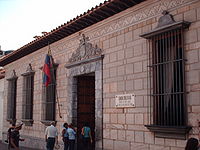
demography
Transport
See also
- Large Cities Climate Leadership Group
ReferencesISBN links support NWE through referral fees
- ↑ The Principal Agglomerations of the World, City Population. Retrieved December 17, 2007.
- ↑ Airships to tackle Caracas crime, BBC News. Retrieved December 17, 2007.
- ↑ Venezuela, Consular Information Sheet, U.S. Department of State. Retrieved December 17, 2007.
- ↑ Venezuela serves up record stew, BBC News. Retrieved December 17, 2007.
- ↑ El Museo de los Niños, home page. In Spanish. Retrieved December 17, 2007.
- ↑ Universidad Central de Venezuela, home page. In Spanish.
- ↑ Complejo Cultural Teresa Carreño, home page. In Spanish. Retrieved December 17, 2007.
- World Fact Book 2008 Venezuela Retrieved August 20, 2008.
External links
- (Spanish) Caracas Virtual - Informative portal of the city.
- Caracas Brief Information Travel Guide
- Backpacking in Caracas
- Caracas Lions Baseball Club
- Caracas News from World News
- Caracas Stock Exchange
- Lonely Planet - Caracas
- Maiquetia Airport (serves Caracas)
- VenezuelaTuya's Caracas Tourism Site
-
- Mapping from Multimap or GlobalGuide or Google Maps
- Satellite image from WikiMapia
- Mapping from OpenStreetMap
Credits
New World Encyclopedia writers and editors rewrote and completed the Wikipedia article in accordance with New World Encyclopedia standards. This article abides by terms of the Creative Commons CC-by-sa 3.0 License (CC-by-sa), which may be used and disseminated with proper attribution. Credit is due under the terms of this license that can reference both the New World Encyclopedia contributors and the selfless volunteer contributors of the Wikimedia Foundation. To cite this article click here for a list of acceptable citing formats.The history of earlier contributions by wikipedians is accessible to researchers here:
The history of this article since it was imported to New World Encyclopedia:
Note: Some restrictions may apply to use of individual images which are separately licensed.



